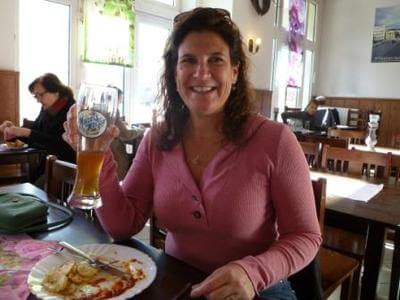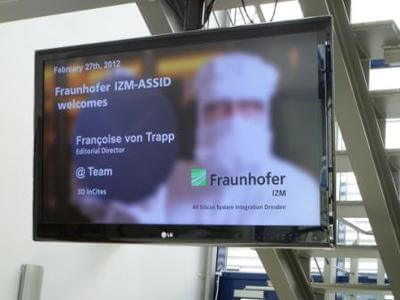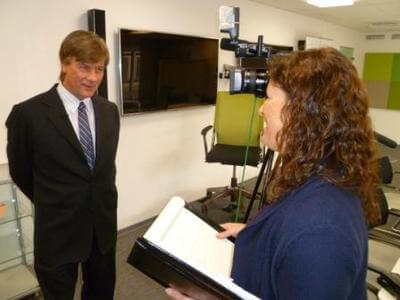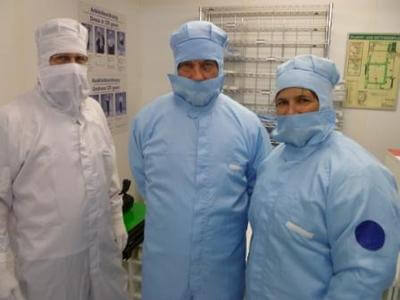I usually never miss the Academy Awards, but this year I am in Germany visiting Fraunhofer IZM ASSID in Dresden for a 3D InCites sponsored site visit, and decided against getting up at 2am to see first hand who won Best Picture. I was invited by M. Juergen Wolf, who manages and coordinates IZM-ASSID (which stands for all silicon system integration Dresden), to come and see what Fraunhofer’s program is all about. Unlike other site visits, this time I brought along 3D InCites staff videographer, Steve Rayle, to see if we couldn’t make an Oscar winner of our own. We arrived in Berlin on Sunday afternoon, and had the rest of the day to recover from the flight and do some sightseeing before work got underway early Monday. Recovering included Indulging in some local fare (beer, currywurst, etc) and strolling through Alexanderplatz and the Tiergarten in what was formerly East Berlin, to snap some photos of the the TV tower, Berliner Dom, and Rotes Rathaus. (As usual with a business trip, there isn’t much time for real sightseeing; we’re here on a mission.) The day was not without its mishaps, however. I experience a good hour of panic when I thought my passport had fallen out of my purse, but it was safe in my computer bag back in the hotel room.  Juergen picked us up bright and early and chauffeured us to Dresden. On the drive, he explained Fraunhofer’s 3D vision to combine heterogeneous technologies like ASICS, sensors, memory and transceiver devices all together in one process as a wafer level package (WLP). At ASSID, he said the facility is designed for prototyping and low volume manufacturing. They are focused on back end of line processes through final assembly. “We’re not just dealing with TSV,” explained Wolf, “We’re also dealing with the 3D stack from the assembly perspective.” I also gained some insight about the German approach to funding such research. Wolf explained that for national funding, there needs to be an end-use motive. Why do we need this technology? “The end-use application must be clear.” He said, whether it is for automotive, power electronics, medical electronics, or industrial application. For European funded projects, the process can be more complicated, can involve multiple organizations and may be technology driven. A third approach is customer-driven with a target product in mind. In these cases, the rules around IP ownership are established in advance by the participating partners. (Needless to say, we learned a lot in two hours. You’ll read more about it once I compose the full length-feature.)
Juergen picked us up bright and early and chauffeured us to Dresden. On the drive, he explained Fraunhofer’s 3D vision to combine heterogeneous technologies like ASICS, sensors, memory and transceiver devices all together in one process as a wafer level package (WLP). At ASSID, he said the facility is designed for prototyping and low volume manufacturing. They are focused on back end of line processes through final assembly. “We’re not just dealing with TSV,” explained Wolf, “We’re also dealing with the 3D stack from the assembly perspective.” I also gained some insight about the German approach to funding such research. Wolf explained that for national funding, there needs to be an end-use motive. Why do we need this technology? “The end-use application must be clear.” He said, whether it is for automotive, power electronics, medical electronics, or industrial application. For European funded projects, the process can be more complicated, can involve multiple organizations and may be technology driven. A third approach is customer-driven with a target product in mind. In these cases, the rules around IP ownership are established in advance by the participating partners. (Needless to say, we learned a lot in two hours. You’ll read more about it once I compose the full length-feature.)  Once we arrived at the Fraunhofer IZM ASSID campus, it was time to make a movie. This was a first for me, and it’s amazing what goes into setting the right scene. We spent a good amount of time choosing the right backdrop for the interview. Juergen gave an Academy Award-winning performance; we had it in the can in just a few takes. Then it was off to the class 1000 clean room for suiting up and shooting the fun part: tools and technicians in action. I won’t go into the details here, because you never want to spoil the ending of a good movie. You’ll just have wait for it to come out on the big screen of 3D InCites in a few weeks (true masterpieces take time!) I’m thinking Best Original Documentary might be the right category.
Once we arrived at the Fraunhofer IZM ASSID campus, it was time to make a movie. This was a first for me, and it’s amazing what goes into setting the right scene. We spent a good amount of time choosing the right backdrop for the interview. Juergen gave an Academy Award-winning performance; we had it in the can in just a few takes. Then it was off to the class 1000 clean room for suiting up and shooting the fun part: tools and technicians in action. I won’t go into the details here, because you never want to spoil the ending of a good movie. You’ll just have wait for it to come out on the big screen of 3D InCites in a few weeks (true masterpieces take time!) I’m thinking Best Original Documentary might be the right category. 
 I’m ready for my close-up, Steve.
I’m ready for my close-up, Steve.  Cleaning the camera equipment for the cleanroom
Cleaning the camera equipment for the cleanroom  Ready for anything….
Ready for anything….Tomorrow we’re headed to Schaerding, Austria to shoot our second film, EV Group, the Sequel. The company’s facility has reportedly doubled in size, and I can’t wait to see the changes since my last visit in 2010. ~ F.v.T.




















